5th Infantry Division (United States)
| 5th Infantry Division | |
|---|---|
|
5th Infantry Division shoulder sleeve insignia | |
| Active |
1917–21 1939–46 1947–92 |
| Country |
|
| Branch |
|
| Type | Infantry |
| Size | Division |
| Nickname(s) | "Red Diamond",[1] "Red Devils" |
| Motto(s) | We Will |
| Engagements |
|
| Commanders | |
| Notable commanders | Bernard W. Rogers |
The 5th Infantry Division (Mechanized)—nicknamed the "Red Diamond",[1] the "Red Devils", or "die Roten Teufel"—was an infantry division of the United States Army that served in World War I, World War II and the Vietnam War, and with NATO and the U.S. Army III Corps. It was disbanded and deactivated on 24 November 1992.[2]
World War I
The 5th Division was activated on 11 December 1917 at Camp Logan, near Houston, Texas.[3] The entire division had arrived in France by 1 May 1918 and components of the units were deployed into the front line.[4]
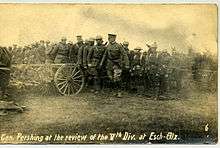
Units associated with the division included:[3]
- 9th Infantry Brigade
 60th Infantry Regiment
60th Infantry Regiment 61st Infantry Regiment
61st Infantry Regiment- 14th Machine Gun Battalion
- 10th Infantry Brigade
 6th Infantry Regiment
6th Infantry Regiment 11th Infantry Regiment
11th Infantry Regiment- 15th Machine Gun Battalion
- 5th Field Artillery Brigade
- Division Troops
- 13th Machine Gun Battalion
 7th Engineer Regiment
7th Engineer Regiment- 9th Field Signal Battalion
- Headquarters Troop
- Trains
- 5th Train Headquarters and Military Police
- 5th Ammunition Train
- 5th Supply Train
- 7th Engineer Train
- 5th Sanitary Train (Ambulance Companies and Field Hospitals 17, 25, 29, 30)
The 5th Division trained with French Army units from 1 to 14 June 1917.[3] The first soldiers of the unit to be killed in action died on 14 June of that year. On 12 September, the unit was part of a major attack that reduced the salient at St. Mihiel.[4] The division served in the Army of Occupation, being based in Belgium and Esch-sur-Alzette, Luxembourg until it departed Europe. The division returned to the United States through the New York Port of Embarkation at Hoboken, New Jersey on 21 July 1919 and was stationed at Camp Gordon, Georgia until October 1920. After that date, it was stationed at Camp Jackson, South Carolina. On 4 October 1921 the 5th Division was inactivated except for the 10th Infantry Brigade and its supporting elements.[5]
World War II
The 5th Division was provisionally activated in August 1936 at Fort Knox, Kentucky for the Second Army's Maneuvers using the 10th Infantry Brigade and the West Virginia Army National Guard's 201st Infantry Regiment. On 16 October 1939 the 5th Division was reactivated as part of the United States mobilization in response to the outbreak of World War II in Europe in September 1939, being formed at Fort McClellan, Alabama under the command of Brigadier General Campbell Hodges.[5]
The following spring, in 1940, the division was sent to Fort Benning, Georgia, and then temporarily to Louisiana for training exercises, before being transferred to Fort Benjamin Harrison at the end of May 1940. That December the division relocated to Fort Custer, Michigan, from where it participated in the Tennessee maneuvers. The division went next to Camp Joseph T. Robinson, Arkansas, in August 1941 for staging into both the Arkansas and Louisiana maneuvers before returning to Fort Custer that October. The division, under the command of Major General Cortlandt Parker from August, was stationed there when the Japanese attacked Pearl Harbor and Germany declared war on the United States in December 1941, thus bringing the United States into the conflict. As the winter passed the division was brought up to strength and fully equipped for forward deployment into a war zone. During April 1942, the 5th Division received its overseas orders and departed the New York Port of Embarkation (NYPOE) at the end of the month for Iceland. The 5th Division debarked there in May 1942, where it replaced the British garrison on the island outpost along the Atlantic convoy routes, and a year later was reorganized and re-designated as the 5th Infantry Division on 24 May 1943.[6]
Normandy
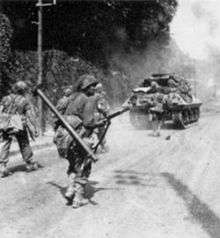
The 5th Infantry Division, now commanded by Major General Stafford LeRoy Irwin, left Iceland in early August 1943 and was sent to England to prepare and train for the eventual invasion of Northwest Europe, then scheduled for the spring of 1944. After two years of training the 5th ID landed in Normandy on Utah Beach, 9 July 1944, over a month after the initial D-Day landings, and four days later took up defensive positions in the vicinity of Caumont. Launching a successful attack at Vidouville 26 July, the division drove on southeast of Saint-Lô, attacked and captured Angers, 9–10 August, captured Chartres, (assisted by the 7th Armored Division), 18 August,[7] pushed to Fontainebleau, crossed the Seine at Montereau, 24 August, crossed the Marne and seized Reims, 30 August, and positions east of Verdun. The division then prepared for the assault on Metz, 7 September.[8] In mid-September a bridgehead was secured across the Moselle, south of Metz, at Dornot and Arnaville after two attempts. The first attempt at Dornot by the 11th Infantry Regiment failed. German-held Fort Driant played a role in repulsing this crossing. A second crossing by the 10th Infantry Regiment at Arnaville was successful.[9] The division continued operations against Metz, 16 September to 16 October 1944, withdrew, then returned to the assault on 9 November. Metz finally fell 22 November. The division crossed the German border, 4 December, captured Lauterbach (a suburb of Völklingen) on the 5th, and elements reached the west bank of the Saar River, 6 December, before the division moved to assembly areas.
On 16 December the Germans launched their winter offensive in the Ardennes forest, the Battle of the Bulge, and on the 18th the 5th ID was thrown in against the southern flank of the Bulge, helping to reduce it by the end of January 1945. In February and March, the division drove across and northeast of the Sauer, where it smashed through the Siegfried Line and later took part in the Allied invasion of Germany.
Across the Rhine
The 5th ID crossed the Rhine River on the night of 22 March 1945. After capturing some 19,000 German soldiers, the division continued to Frankfurt-am-Main, clearing and policing the town and its environs, 27–29 March.[10] In April the 5th ID, now commanded by Major General Albert E. Brown, after Major General Irwin's promotion to command of XII Corps, took part in clearing the Ruhr Pocket and then drove across the Czechoslovak border, 1 May, reaching Volary and Vimperk as the war in Europe ended.[10]
Casualties
- Total battle casualties: 12,818[11]
- Killed in action: 2,298[12]
- Wounded in action: 9,549[13]
- Missing in action: 288[14]
- Prisoner of war: 683[15]
Order of battle
Under the new "triangular" organization, units assigned included:[16]
- Division Headquarters
- 5th Division Artillery
- 19th Field Artillery Battalion, (18x 105mm Howitzers)
- 46th Field Artillery Battalion, (18x 105mm Howitzers)
- 50th Field Artillery Battalion, (18x 105mm Howitzers)
- 21st Field Artillery Battalion, (18x 155mm Howitzers)
- 7th Combat Engineer Battalion
- 5th Reconnaissance Troop (Mechanized)
- 5th Medical Battalion
- Special Troops
- 705th Ordnance Light Maintenance Company
- 5th Quartermaster Company
- 5th Signal Company
- Military Police Platoon
- Band
Post-World War II
Following World War II, the 5th Infantry Division was inactivated on 20 September 1946. However, the division was reactivated on 15 July 1947 under Brigadier General John H. Church. The 1950s saw the division in West Germany as part of the US contribution to NATO though the division later returned to the United States.
Vietnam War
%2C_takes_down_barbed_tape_(a_modified_form..._-_NARA_-_531456.tif.jpg)
When the 1st Infantry Division deployed to Vietnam in 1965, additional maneuver battalions were required; thus two infantry battalions from the 2nd Brigade, 5th Infantry Division, at Fort Devens, Massachusetts, were relieved and assigned to "The Big Red One."[18] In September 1965, the 2nd Brigade, 5th Infantry Division was moved, minus personnel, to Fort Carson, Colorado, and refilled there. The remaining personnel at Fort Devens formed the basis of the 196th Infantry Brigade.
By 1968 the division was stationed at Fort Carson, Colorado, as a mechanized formation.[19] 1st Brigade, 5th Infantry Division was dispatched to Vietnam after the Tet Offensive to replace a U.S. Marine Corps unit. The brigade, consisting of one battalion each of infantry, mechanized infantry, and armor, served there from July 1968 until 1971. Combat units included 1st Battalion, 11th Infantry; 1st Battalion, 61st Infantry (Mechanized); 1st Battalion, 77th Armor; A Troop, 4th Squadron, 12th Cavalry; and 5th Battalion, 4th Artillery.(Society of the Fifth Division) On 22 August 1971, the colors of 1st Brigade, 5th Infantry Division were cased and the brigade was inactivated at Fort Carson. Its final assignment was to III Corps, with the mission of reinforcing Europe if a general war was to break out there.[20] In September 1969 the 4th Brigade, 5th Infantry Division was activated at Fort Carson, although, on the later return of 4th Infantry Division home from Vietnam in December 1970, the 4th Division replaced the 5th Division at Fort Carson, whereupon the 5th Division was inactivated.
Post-Vietnam
On 21 October 1974 the 1st Brigade, 5th Infantry Division was reactivated at Fort Polk, LA., as part of the Army's new 24-division force. Due to lack of sufficient housing, the brigade initially only had two maneuver battalions. (Maneuver and Firepower, Chap XIII) The division base and a second brigade was organized in 1975-77, and the Louisiana Army National Guard's 256th Infantry Brigade was assigned as the 'round-out' third brigade of the division.
In 1989, units of the 5th Division, based at Fort Polk, Louisiana, deployed in support of Operation Nimrod Dancer to protect American interests in Panama. First Battalion, 61st Infantry (Mechanized), "Roadrunners" (1st Brigade, 5th ID) was one of the first reinforcing units and remained there until September when there was a hand over to 4th Battalion, Sixth Infantry(Mechanized), "Regulars" (2nd Brigade, 5th ID).[2] 4–6 Infantry was in country and assisted during Operation Just Cause helping to overthrow Panamanian leader Manuel Noriega, and also assisted in an emergency extraction of Delta Force operators engaged in Operation Acid Gambit when their helicopter went down.
Organization

Upon notification of deployment to Germany to defeat a Warsaw Pact attack, the 256th Mechanized Infantry Brigade, Louisiana Army National Guard would deploy as the division's third maneuver brigade.[21]
Division Headquarters and Headquarters Company
- 1st Brigade
- Headquarters and Headquarters Company
 1st Battalion, 70th Armor Regiment, (M1 Abrams)
1st Battalion, 70th Armor Regiment, (M1 Abrams) 4th Battalion, 35th Armor Regiment, (M1 Abrams)
4th Battalion, 35th Armor Regiment, (M1 Abrams) 5th Battalion, 6th Infantry Regiment, (M113)
5th Battalion, 6th Infantry Regiment, (M113)
- 2nd Brigade
- Headquarters and Headquarters Company
 3rd Battalion, 70th Armor Regiment, (M1 Abrams)
3rd Battalion, 70th Armor Regiment, (M1 Abrams) 3rd Battalion, 6th Infantry Regiment, (M113)
3rd Battalion, 6th Infantry Regiment, (M113) 4th Battalion, 6th Infantry Regiment, (M113)
4th Battalion, 6th Infantry Regiment, (M113)
- 4th Brigade (Aviation)
- Headquarters and Headquarters Company
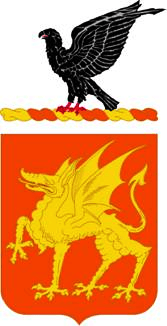 3rd Squadron, 1st Cavalry Regiment, (40x M3 Bradley, 10x M113, 4x M106, 4x M577, 8x AH-1F, 12x OH-58C, 1x UH-1H)
3rd Squadron, 1st Cavalry Regiment, (40x M3 Bradley, 10x M113, 4x M106, 4x M577, 8x AH-1F, 12x OH-58C, 1x UH-1H) 1st Battalion, 5th Aviation Regiment, (21x AH-1F, 13x OH-58C, 3x UH-1H)
1st Battalion, 5th Aviation Regiment, (21x AH-1F, 13x OH-58C, 3x UH-1H) 2nd Battalion, 5th Aviation Regiment, (21x UH-1H, 6x OH-58A, 6x OH-58D, 3x EH-60)
2nd Battalion, 5th Aviation Regiment, (21x UH-1H, 6x OH-58A, 6x OH-58D, 3x EH-60)
- 5th Infantry Division Artillery (DIVARTY)
- Headquarters and Headquarters Battery
 4th Battalion, 1st Field Artillery Regiment, (24x M109A3)[22]
4th Battalion, 1st Field Artillery Regiment, (24x M109A3)[22] 5th Battalion, 1st Field Artillery Regiment, (24x M109A3)
5th Battalion, 1st Field Artillery Regiment, (24x M109A3) 1st Battalion, 141st Field Artillery Regiment, (24x M109A3) (LA ARNG)[23]
1st Battalion, 141st Field Artillery Regiment, (24x M109A3) (LA ARNG)[23]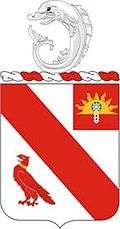 C Battery, 21st Field Artillery Regiment, (9x M270 MLRS)
C Battery, 21st Field Artillery Regiment, (9x M270 MLRS)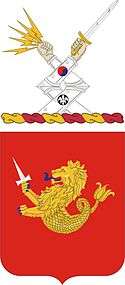 H Battery, 25th Field Artillery Regiment, (Target Acquisition)
H Battery, 25th Field Artillery Regiment, (Target Acquisition)
- 5th Infantry Division Support Command (DISCOM)
- Headquarters and Headquarters Company (also Division Materiel Management Center)
- 75th Forward Support Battalion
- 105th Forward Support Battalion
- 705th Main Support Battalion
 7th Combat Engineer Battalion, (8x M60 AVLB, 8x M728, 4x M88, 12x MAB bridge modules)
7th Combat Engineer Battalion, (8x M60 AVLB, 8x M728, 4x M88, 12x MAB bridge modules) 3rd Battalion, 3rd Air Defense Artillery Regiment, (12x MIM-72 Chaparral, 27x M163 VADS Vulcan, 60x FIM-92 Stinger)
3rd Battalion, 3rd Air Defense Artillery Regiment, (12x MIM-72 Chaparral, 27x M163 VADS Vulcan, 60x FIM-92 Stinger)- 105th Signal Battalion
- 105th Military Intelligence Battalion, (Combat Electronic Warfare & Intelligence)
- 5th Military Police Company
- 45th Chemical Company
Commanders
(Partial list)[24]
Inactivation
The division was deactivated for the final time on 24 November 1992, and reflagged as the U.S. 2nd Armored Division as part of the post-Cold War drawdown of US forces. The 2nd Armored Division moved from Fort Polk to Fort Hood, Texas in 1993, with the majority of the 5th Division's equipment.[2]
Though it was inactivated, the division was identified as the fourth highest priority inactive division in the United States Army Center of Military History's lineage scheme due to its numerous accolades and long history. All of the division's flags and heraldic items were moved to the National Infantry Museum at Fort Benning, Georgia following its inactivation. Should the U.S. Army decide to activate more divisions in the future, the center will most likely suggest the first new division be the 7th Infantry Division, the second be the 9th Infantry Division, the third be the 24th Infantry Division, the fourth be the 5th Infantry Division, and the fifth be the 2d Armored Division.[25]
In popular culture
In the Axis & Allies miniatures role-playing game, a US infantry unit was designated "Red Devil Captain".
In the Twilight: 2000 role-playing game, players start out as members of the 5th ID in July 2000, after the division is overrun by Soviet and Polish units near Kalisz, Poland during a hypothetical World War III .
Notes
- 1 2 "Special Unit Designations". United States Army Center of Military History. 21 April 2010. Archived from the original on 9 June 2010. Retrieved 24 June 2010.
- 1 2 3 "5th Infantry Division (Mechanized)". GlobalSecurity.org. 23 May 2005. Retrieved 9 March 2011.
- 1 2 3 Order of Battle of the United States Land Forces in the World War, Center of Military History 1988
- 1 2 Barta, Edward J. "The Fifth Infantry Division: World War I". The Society of the Fifth Division, United States Army. Retrieved 9 March 2011.
- 1 2 Clay, Steven E. (2010). U.S. Army Order of Battle 1919-1941. Combat Studies Institute Press.
- ↑ Stanton, Shelby, World War II Order of Battle: An Encyclopedic Reference to U.S. Army Ground Forces from Battalion through Division, 1939-1946 (Revised Edition, 2006), Stackpole Books, p. 83.
- ↑ Stanton, Shelby L. World War II Order of Battle, Gallahad Books, 1991, p. 84, ISBN 0-88365-775-9
- ↑ Stanton, p. 84.
- ↑ MacDonald, Charles B., Three Battles: Arnaville, Altuzzo, and Schmidt (United States Army Center of Military History: Washington, D.C.) 1993 reprint of 1952 edition, p. 35, 95.
- 1 2 "World War II Divisional Combat Chronicles". army.mil.
- ↑ Army Battle Casualties and Nonbattle Deaths in World War II, Final Report (Statistical and Accounting Branch Office of the Adjutant General, 1 June 1953)
- ↑ Army Battle Casualties and Nonbattle Deaths in World War II, Final Report (Statistical and Accounting Branch Office of the Adjutant General, 1 June 1953)
- ↑ Army Battle Casualties and Nonbattle Deaths in World War II, Final Report (Statistical and Accounting Branch Office of the Adjutant General, 1 June 1953)
- ↑ Army Battle Casualties and Nonbattle Deaths in World War II, Final Report (Statistical and Accounting Branch Office of the Adjutant General, 1 June 1953)
- ↑ Army Battle Casualties and Nonbattle Deaths in World War II, Final Report (Statistical and Accounting Branch Office of the Adjutant General, 1 June 1953)
- ↑ "The Fifth Infantry Division: World War II". The Society of the Fifth Division, United States Army. Retrieved 9 March 2011.
- ↑ "5th Infantry Division". army.mil.
- ↑ John B. Wilson, Maneuver and Firepower: The Evolution of Divisions and Separate Brigades, Chapter Flexible Response: The Buildup of the Army, Center of Military History, United States Army, WASHINGTON, D. C., 1998, accessed November 2011
- ↑ Stanton, Shelby L. (2003). Vietnam Order of Battle. Stackpole Books. p. 336. ISBN 978-0-8117-0071-9.
- ↑ David C. Isby & Charles Kamps Jr., Armies of NATO's Central Front, Jane's Publishing Company, 1985.
- ↑ Gordon L. Rottmen, Inside the US Army Today, Osprey Publishing 1988
- ↑ "4th Battalion, 1st Field Artillery Regiment | Lineage and Honors | U.S. Army Center of Military History (CMH)". www.history.army.mil. Retrieved 2015-10-23.
- ↑ "A Lineage of Honor- The Washington Artillery in the 20th Century". www.washingtonartillery.com. Retrieved 2015-10-23.
- ↑ Yves J. Bellanger, Commanders of the 5th Infantry Division, 1917-1970, retrieved 24 March 2014
- ↑ "Reflagging in the Army:Appendix D". army.mil.
Further reading
- Society of the Fifth division, United States army, veterans of the world war, and Kenyon Stevenson. The Official History of the Fifth Division, U.S.A., During the Period of Its Organization and of Its Operations in the European World War, 1917-1919. The Red Diamond (Meuse) Division. Washington, D.C.: The Society of the Fifth division, 1919. OCLC 2687689 or OCLC 607820371
External links
- Society of the 5th Infantry Division
- 5th Infantry Division Directory
- The short film Big Picture: Recall is available for free download at the Internet Archive
- Organization of the 5th Mechanized Infantry Division At Fort Polk, LA
- 5th Infantry Division Order of Battle in the ETO
- 5th Infantry Division in Luxembourg 1918-1919
